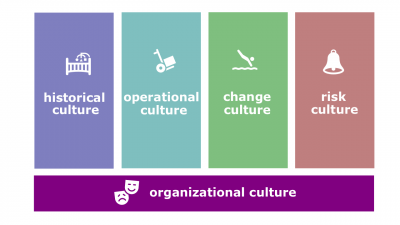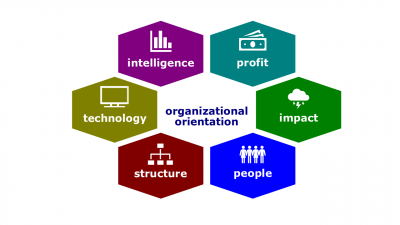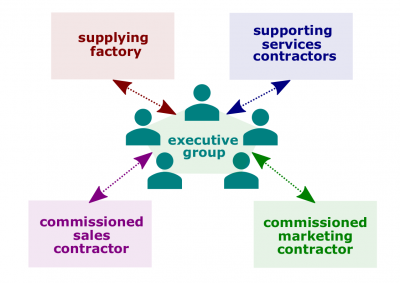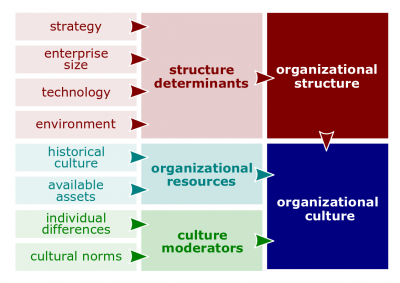Difference between revisions of "Organizational Culture Quarter"
(→Concepts) |
|||
| (30 intermediate revisions by 2 users not shown) | |||
| Line 3: | Line 3: | ||
==Outline== | ==Outline== | ||
| − | ''[[Enterprise Intelligence Quarter]] is the predecessor lecture. In the [[enterprise | + | ''[[Enterprise Intelligence Quarter]] is the predecessor lecture. In the [[enterprise envisioning]] series, the previous lecture is [[Workforce Arrangements Quarter]].'' |
===Concepts=== | ===Concepts=== | ||
#[[File:Organizational-culture.png|400px|thumb|right|[[Organizational culture]]]]'''[[Organizational culture]]'''. A system of the shared meaning, values, principles, traditions, and ways of doing things held by members of the [[organization]] that influence the way organizational members act and that distinguish the organization from other organizations. Every [[organizational culture]] can be divided in four parts: (1) [[historical organizational culture]] or the culture envisioned by the founders and others that is no longer executed, (2) [[operational culture]] or the culture exercised by an enterprise today for its [[operations]], (3) [[change culture]] or the culture related to change in the enterprise, and (4) [[risk culture]] or the culture related to handling risks. | #[[File:Organizational-culture.png|400px|thumb|right|[[Organizational culture]]]]'''[[Organizational culture]]'''. A system of the shared meaning, values, principles, traditions, and ways of doing things held by members of the [[organization]] that influence the way organizational members act and that distinguish the organization from other organizations. Every [[organizational culture]] can be divided in four parts: (1) [[historical organizational culture]] or the culture envisioned by the founders and others that is no longer executed, (2) [[operational culture]] or the culture exercised by an enterprise today for its [[operations]], (3) [[change culture]] or the culture related to change in the enterprise, and (4) [[risk culture]] or the culture related to handling risks. | ||
| + | #*[[Culture]]. The set of shared [[values]], beliefs, [[attitude]]s, [[social norm]]s, and [[material symbol]]s that characterizes some group of people such as a [[family]], an [[organization]], or a nation. | ||
#*[[Strong organizational culture]]. An [[organizational culture]] in which the key values are intensely held and widely shared. | #*[[Strong organizational culture]]. An [[organizational culture]] in which the key values are intensely held and widely shared. | ||
#*[[Positive organizational culture]]. An [[organizational culture]] that emphasizes building on employee strengths, rewards more than punishes, and emphasizes individual vitality and growth. | #*[[Positive organizational culture]]. An [[organizational culture]] that emphasizes building on employee strengths, rewards more than punishes, and emphasizes individual vitality and growth. | ||
#*[[Organizational subculture]]. A miniculture within an [[organization]], typically defined by department designations and geographical separation. | #*[[Organizational subculture]]. A miniculture within an [[organization]], typically defined by department designations and geographical separation. | ||
| − | #'''[[Organization]]'''. A consciously coordinated social unit, usually a [[legal entity]], within an [[enterprise]] under the management of a single individual or board, with a clearly defined boundary that functions on a relatively continuous basis to achieve a common goal or set of goals. Organizations operate on a continuous basis, as opposed to | + | #'''[[Organization]]'''. A consciously coordinated social unit, usually a [[legal entity]], within an [[enterprise]] under the management of a single individual or board, with a clearly defined boundary that functions on a relatively continuous basis to achieve a common goal or set of goals. Organizations operate on a continuous basis, as opposed to a [[project team]], which may be disbanded once its objectives are achieved. |
#*[[Manufacturing organization]]. An organization that produces physical goods. | #*[[Manufacturing organization]]. An organization that produces physical goods. | ||
#*[[Service organization]]. An organization that produces nonphysical products in the form of services. | #*[[Service organization]]. An organization that produces nonphysical products in the form of services. | ||
| Line 20: | Line 21: | ||
#*[[Open innovation]]. Opening up the search for new ideas beyond the organization's boundaries and allowing innovations to easily transfer inward and outward. | #*[[Open innovation]]. Opening up the search for new ideas beyond the organization's boundaries and allowing innovations to easily transfer inward and outward. | ||
#*[[Organization modeling]]. The analysis technique used to describe roles, responsibilities and reporting structures that exist within an organization. | #*[[Organization modeling]]. The analysis technique used to describe roles, responsibilities and reporting structures that exist within an organization. | ||
| + | #'''[[Organizational unit]]'''. Any recognized association of people in the context of an organization or enterprise. The units are usually created on a basis of [[departmentalization]]. | ||
| + | #*[[File:Virtual-organization.png|400px|thumb|right|[[Virtual organization]]]][[Virtual organization]]. An [[organization]] in which [[organizational unit]]s mostly utilize [[virtual arrangement]]s for the [[enterprise workforce]]. A [[virtual organization]] usually outsources major business functions. | ||
| + | #*[[Mechanistic organization]]. An [[organization]] in which [[organizational unit]]s mostly utilize the [[mechanistic model]] for its [[workforce arrangement]]. | ||
| + | #*[[Matrix organization]]. An [[organization]] in which [[organizational unit]]s mostly utilize the [[matrix model]] for its [[workforce arrangement]]. | ||
#'''[[Organic organization]]'''. An [[organization]] in which [[organizational unit]]s mostly utilize the [[organic model]] for its [[workforce arrangement]]. | #'''[[Organic organization]]'''. An [[organization]] in which [[organizational unit]]s mostly utilize the [[organic model]] for its [[workforce arrangement]]. | ||
#*[[Lean organization]]. An organization that understands what customers want, identifies customer value by analyzing all activities required to produce products, and then optimizes the entire process from the customer's perspective. | #*[[Lean organization]]. An organization that understands what customers want, identifies customer value by analyzing all activities required to produce products, and then optimizes the entire process from the customer's perspective. | ||
| − | #*[[Learning organization]]. An [[organization]] that has developed the continuous capacity to adapt and change. | + | #*[[Learning organization]]. An [[organization]] that has developed the continuous [[capacity]] to adapt and change. |
#*[[Skunkworks]]. A small group within a large organization, given a high degree of [[autonomy]] and unhampered by corporate bureaucracy, whose mission is to develop a project primarily for the sake of radical innovation. | #*[[Skunkworks]]. A small group within a large organization, given a high degree of [[autonomy]] and unhampered by corporate bureaucracy, whose mission is to develop a project primarily for the sake of radical innovation. | ||
| − | #'''[[ | + | #'''[[Multinational corporation]]'''. A broad term that refers to any and all types of international companies that maintain operations in multiple countries. |
| − | # | + | #*[[Global company]]. A [[multinational corporation]] that centralizes management and other decisions in the home country. |
| − | #*[[ | + | #*[[Foreign subsidiary]]. Directly investing in a foreign country by setting up a separate and independent production facility or office. |
| − | + | #*[[Multidomestic corporation]]. A [[multinational corporation]] that decentralizes management and other decisions to the local country. | |
| − | #*[[ | + | #*[[Transnational organization]] (or borderless organization). A [[multinational corporation]] in which artificial geographical barriers are eliminated. |
| − | |||
#'''[[Performing organization]]'''. The enterprise whose employees are most directly involved in doing the work of the project. | #'''[[Performing organization]]'''. The enterprise whose employees are most directly involved in doing the work of the project. | ||
#*[[Functional organization]]. An organization structure in which staff are grouped hierarchically by specialty (e.g., production, marketing, engineering, and accounting at the top level; with engineering, further divided into mechanical, electrical, and others). | #*[[Functional organization]]. An organization structure in which staff are grouped hierarchically by specialty (e.g., production, marketing, engineering, and accounting at the top level; with engineering, further divided into mechanical, electrical, and others). | ||
| − | #*[[Projectized organization]]. Any organizational structure in which the project manager has full authority to assign priorities and to direct the work of individuals assigned to the project. | + | #*[[Projectized organization]]. Any [[organizational structure]] in which the project manager has full authority to assign priorities and to direct the work of individuals assigned to the project. These organizations may utilize either [[projectized arrangement|projectized]] or [[multiteam arrangement]]. |
| − | |||
#'''[[Organizational survival]]'''. The degree to which an organization is able to exist and grow over the long term. | #'''[[Organizational survival]]'''. The degree to which an organization is able to exist and grow over the long term. | ||
#*[[Sustainability]]. (1) An organization's ability to achieve its business goals and increase long-term shareholder value by integrating economic, environmental, and social opportunities into its business strategies; (2) Organization practices that can be sustained over a long period of time because the tools or structures that support them are not damaged by the processes. | #*[[Sustainability]]. (1) An organization's ability to achieve its business goals and increase long-term shareholder value by integrating economic, environmental, and social opportunities into its business strategies; (2) Organization practices that can be sustained over a long period of time because the tools or structures that support them are not damaged by the processes. | ||
| Line 39: | Line 42: | ||
#'''[[Entrepreneurial venture]]'''. An organization that pursues opportunities, and characterized by innovative practices, and have growth and profitability as their main goals. | #'''[[Entrepreneurial venture]]'''. An organization that pursues opportunities, and characterized by innovative practices, and have growth and profitability as their main goals. | ||
#*[[Self-employment]]. Individuals who work for profit or fees in their own business, profession, trade, or farm. | #*[[Self-employment]]. Individuals who work for profit or fees in their own business, profession, trade, or farm. | ||
| − | #*[[ | + | #*[[Property licensing]]. An organization gives another organization the right to make or sell its products using its technology or product specifications. |
#*[[Franchising]]. An organization gives another organization the right to use its name and operating methods. | #*[[Franchising]]. An organization gives another organization the right to use its name and operating methods. | ||
#*[[Strategic alliance]]. A partnership between an organization and foreign company partner(s) in which both share resources and knowledge in developing new products or building production facilities. | #*[[Strategic alliance]]. A partnership between an organization and foreign company partner(s) in which both share resources and knowledge in developing new products or building production facilities. | ||
| Line 51: | Line 54: | ||
===Methods=== | ===Methods=== | ||
| + | #'''[[Organizational design]]'''. Creating or changing an [[organizational structure]] including designing a network of [[organizational unit]]s, as well as identifying, documenting, and assigning roles, responsibilities, and reporting relationships to those ''units''. | ||
| + | #*[[Organizational chart]]. The visual representation of an [[organizational structure]]. | ||
| + | #*[[Organizational plan]]. A document that outline how organizational goals are going to be met. | ||
===Instruments=== | ===Instruments=== | ||
| + | #[[File:Culture-determination.png|400px|thumb|right|[[Culture determination model]]]]'''[[Culture determination model]]'''. A [[model]] that has been designed in order to assist in determining features of [[organizational culture]]. | ||
| + | #*[[Institutions]]. [[Cultural factor]]s that lead many organizations to have similar structures, especially those factors that might not lead to adaptive consequences. | ||
| + | #'''[[Material symbol]]'''. What conveys to employees who is important, the degree of egalitarianism top management desires, and the kinds of behavior that are appropriate. | ||
===Practices=== | ===Practices=== | ||
| − | ''[[Resource Planning Quarter]] is the successor lecture. In the [[enterprise | + | ''[[Resource Planning Quarter]] is the successor lecture. In the [[enterprise planning]] series, the next lecture is [[Concept Management Quarter]].'' |
==Materials== | ==Materials== | ||
| Line 66: | Line 75: | ||
==See also== | ==See also== | ||
| + | |||
| + | [[Category:Septem Artes Administrativi]][[Category:Lecture notes]] | ||
Latest revision as of 01:04, 29 December 2020
Organizational Culture Quarter (hereinafter, the Quarter) is a lecture introducing the learners to organizational design primarily through key topics related to organizational structure. The Quarter is the third of four lectures of Organizational Quadrivium, which is the last of seven modules of Septem Artes Administrativi (hereinafter, the Course). The Course is designed to introduce the learners to general concepts in business administration, management, and organizational behavior.
Contents
Outline
Enterprise Intelligence Quarter is the predecessor lecture. In the enterprise envisioning series, the previous lecture is Workforce Arrangements Quarter.
Concepts
- Organizational culture. A system of the shared meaning, values, principles, traditions, and ways of doing things held by members of the organization that influence the way organizational members act and that distinguish the organization from other organizations. Every organizational culture can be divided in four parts: (1) historical organizational culture or the culture envisioned by the founders and others that is no longer executed, (2) operational culture or the culture exercised by an enterprise today for its operations, (3) change culture or the culture related to change in the enterprise, and (4) risk culture or the culture related to handling risks.
- Culture. The set of shared values, beliefs, attitudes, social norms, and material symbols that characterizes some group of people such as a family, an organization, or a nation.
- Strong organizational culture. An organizational culture in which the key values are intensely held and widely shared.
- Positive organizational culture. An organizational culture that emphasizes building on employee strengths, rewards more than punishes, and emphasizes individual vitality and growth.
- Organizational subculture. A miniculture within an organization, typically defined by department designations and geographical separation.
- Organization. A consciously coordinated social unit, usually a legal entity, within an enterprise under the management of a single individual or board, with a clearly defined boundary that functions on a relatively continuous basis to achieve a common goal or set of goals. Organizations operate on a continuous basis, as opposed to a project team, which may be disbanded once its objectives are achieved.
- Manufacturing organization. An organization that produces physical goods.
- Service organization. An organization that produces nonphysical products in the form of services.
- Organizational orientation. The degrees to which organizational culture focuses on enterprise outcome, people, and organizational structure.
- Profit orientation. The degree to which organizational culture focuses on profits rather than on how these profits are achieved.
- People orientation. The degree to which organizational culture takes into account the effects on people in the organization rather than on the enterprise outcomes.
- Structure orientation. The degree to which organizational culture takes into account organizational structure rather than enterprise outcomes or the effects on people.
- Organizational structure. The formal arrangement of jobs within an organization. In other words, an organizational structure is the way in which job tasks are formally divided, grouped, and coordinated.
- Open innovation. Opening up the search for new ideas beyond the organization's boundaries and allowing innovations to easily transfer inward and outward.
- Organization modeling. The analysis technique used to describe roles, responsibilities and reporting structures that exist within an organization.
- Organizational unit. Any recognized association of people in the context of an organization or enterprise. The units are usually created on a basis of departmentalization.
- Virtual organization. An organization in which organizational units mostly utilize virtual arrangements for the enterprise workforce. A virtual organization usually outsources major business functions.
- Mechanistic organization. An organization in which organizational units mostly utilize the mechanistic model for its workforce arrangement.
- Matrix organization. An organization in which organizational units mostly utilize the matrix model for its workforce arrangement.
- Organic organization. An organization in which organizational units mostly utilize the organic model for its workforce arrangement.
- Lean organization. An organization that understands what customers want, identifies customer value by analyzing all activities required to produce products, and then optimizes the entire process from the customer's perspective.
- Learning organization. An organization that has developed the continuous capacity to adapt and change.
- Skunkworks. A small group within a large organization, given a high degree of autonomy and unhampered by corporate bureaucracy, whose mission is to develop a project primarily for the sake of radical innovation.
- Multinational corporation. A broad term that refers to any and all types of international companies that maintain operations in multiple countries.
- Global company. A multinational corporation that centralizes management and other decisions in the home country.
- Foreign subsidiary. Directly investing in a foreign country by setting up a separate and independent production facility or office.
- Multidomestic corporation. A multinational corporation that decentralizes management and other decisions to the local country.
- Transnational organization (or borderless organization). A multinational corporation in which artificial geographical barriers are eliminated.
- Performing organization. The enterprise whose employees are most directly involved in doing the work of the project.
- Functional organization. An organization structure in which staff are grouped hierarchically by specialty (e.g., production, marketing, engineering, and accounting at the top level; with engineering, further divided into mechanical, electrical, and others).
- Projectized organization. Any organizational structure in which the project manager has full authority to assign priorities and to direct the work of individuals assigned to the project. These organizations may utilize either projectized or multiteam arrangement.
- Organizational survival. The degree to which an organization is able to exist and grow over the long term.
- Sustainability. (1) An organization's ability to achieve its business goals and increase long-term shareholder value by integrating economic, environmental, and social opportunities into its business strategies; (2) Organization practices that can be sustained over a long period of time because the tools or structures that support them are not damaged by the processes.
- Institutionalization. A condition that occurs when an organization takes on a life of its own, apart from any of its members, and acquires immortality.
- Entrepreneurial venture. An organization that pursues opportunities, and characterized by innovative practices, and have growth and profitability as their main goals.
- Self-employment. Individuals who work for profit or fees in their own business, profession, trade, or farm.
- Property licensing. An organization gives another organization the right to make or sell its products using its technology or product specifications.
- Franchising. An organization gives another organization the right to use its name and operating methods.
- Strategic alliance. A partnership between an organization and foreign company partner(s) in which both share resources and knowledge in developing new products or building production facilities.
- Joint venture. A specific type of strategic alliance in which the partners agree to form a separate, independent organization for some business purpose.
- Startup stage. The stage of development a startup company is in. There is no explicit rule for what defines each stage of a company, but startups tend to be categorized as seed stage, early stage, mid-stage, and late stage. Most venture capitalists' firms only invest in companies in one or two stages. Some firms, however, manage multiple funds geared toward different stage companies.
Roles
- Entrepreneur. “An entrepreneur is an individual who accepts financial risks and undertakes new financial ventures. The word derives from the French “entre” (to enter) and “prendre” (to take), and in a general sense applies to any person starting a new project or trying a new opportunity.” (Source: wiseGEEK)
- Intraprenuer. “Coined in the 1980s by management consultant Gifford Pinchot, intrapreneurs are used by companies that are in great need of new, innovative ideas. Today, instead of waiting until the company is in a bind, most companies try to create an environment where employees are free to explore ideas. If the idea looks profitable, the person behind it is given an opportunity to become an intrapreneur.” (Source: Investopedia) ‘Intrapreneurs’ hold many similar characteristics to ‘Entrepreneurs’ any may well leave their jobs to pursue a career as an entrepreneur. Companies seek out intrapreneurs to effect change within their organizations.
- Lead investor. A venture capital firm or individual investor that organizes a specific round of funding for a company. The lead investor usually invests the most capital in that round. Also known as "leading the round."
Methods
- Organizational design. Creating or changing an organizational structure including designing a network of organizational units, as well as identifying, documenting, and assigning roles, responsibilities, and reporting relationships to those units.
- Organizational chart. The visual representation of an organizational structure.
- Organizational plan. A document that outline how organizational goals are going to be met.
Instruments
- Culture determination model. A model that has been designed in order to assist in determining features of organizational culture.
- Institutions. Cultural factors that lead many organizations to have similar structures, especially those factors that might not lead to adaptive consequences.
- Material symbol. What conveys to employees who is important, the degree of egalitarianism top management desires, and the kinds of behavior that are appropriate.
Practices
Resource Planning Quarter is the successor lecture. In the enterprise planning series, the next lecture is Concept Management Quarter.



